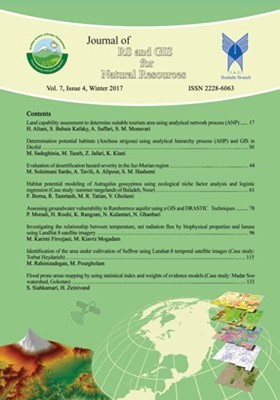Land capability assessment to determine suitable tourism area using analytical network process (ANP)
Subject Areas : Geospatial systems developmentHamideh Aliani 1 , Sasan Babaie Kafaky 2 , Amir Saffari 3 , seyed Masoud Monavari 4
1 - PhD. Student of Environment, Science and Research Branch, Islamic Azad University, Tehran, Iran
2 - Assoc. Prof. College of Agriculture and Natural Resources, Science and Research Branch, Islamic Azad University, Tehran, Iran
3 - Assoc. Prof. College of Geographical Sciences, Kharazmi University
4 - Assis. Prof. College of Environment and Energy, Science and Research Branch, Islamic Azad University, Tehran, Iran
Keywords: Analytical Network Process (ANP), Taleghan, Ecotourism, Weighted linear combination (WLC), Paired comparison,
Abstract :
In this research, in order to allocate land for development of ecotourism, a multi criteria evaluation method based on analytical network process and fuzzy logic was used. The ecological criteria such as soil, climate, water resources, geology and physiographic, as well as socioeconomic criteria, such as land use, distance from road, distance from built-up areas, distance from sightseeing attractions, and distance from tourism facilities were identified and then quantified using fuzzy method. In order to generate a land use map, remotely sensed data of OLI land sat 8 dated was used. Field data were collected in 2015. Thereafter, the factors influencing the allocation of lands to ecotourism were ranked using analytical network process method. Finally, using a weighted linear combination (WLC) operator, all information layers were combined in a ArcGIS®10.1 environment, followed by preparation of the final map of the ecotourism development power. In order to carry out the accuracy assessment, 20% of homogeneous land units which were suitable for ecotourism were randomly selected. The result of field check proved that 94% of the identified land units were completely compatible with natural condition. The obtained results indicate that the ecological criteria account for 0.64 of the final weight in total, suggesting the greater involvement of ecological criteria in developing functionality for ecotourism. The results from the quantitative method (WLC) showed that 75.2% of the study area are capable for ecotourism purposes, although the degree of culpability is varied. The rest (24.8%) has no suitability for ecotourism. From the capable areas, about 30.32% are highly capable for different ecotourism purposes. Concomitant use of fuzzy logic and ANP method for prioritization of criteria provides a more logical and flexible condition for land evaluation based on WLC method.
_||_


